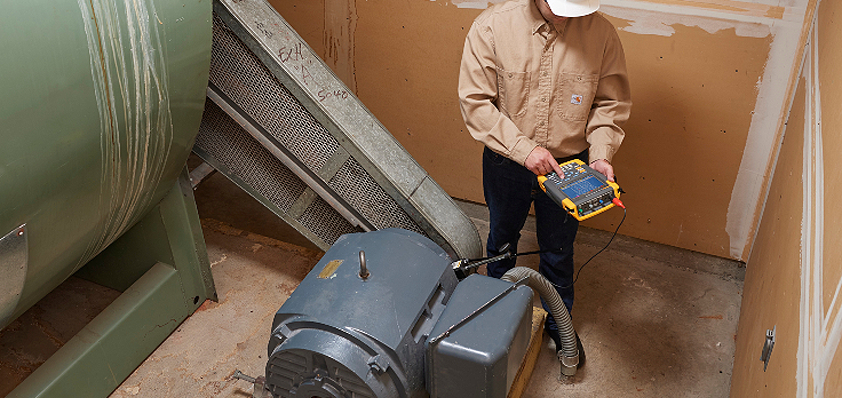
Fluke USA
Motor drives are a ubiquitous technology for transforming the constant voltage from the main AC power supply into a voltage that varies to control motor torque and speed ideal for motors that are driving mechanical equipment loads. Motor drives provide higher efficiency than simple online motors and a degree of control not available on simple directly driven motors. These factors result in energy cost savings, higher production performance and extend the life of the motor.
According to the U.S. Department of Energy (DOE), motor systems are critical to the operation of almost every plant, accounting for 60 percent to 70 percent of all electricity used. The DOE also identifies variable frequency drives (VFD) as a source to provide plants with significant cost savings. Not surprisingly, motor drives are commonly used in many industries and facilities. To ensure uptime in these motor systems, maintenance and troubleshooting is a priority.
Challenges to testing motor drives
Troubleshooting and testing motor drives, also known as VFDs, variable speed drives (VSD) or adjustable speed drives (ASD), are often performed by specialists using several test instruments, including oscilloscopes, digital multimeters or other test tools. Such testing can involve a degree of trial and error, using the age-old process of elimination.
Due to the complexity of the motor systems, testing often occurs annually unless a system begins to fail. Determining where to begin testing can be problematic considering there is usually a lack of, or incomplete, work history for the equipment. This includes documentation of specific tests and measurements performed previously, work completed or the as-left condition of individual components.
Advances in testing technology have eliminated some of the challenges. Newer instruments are designed to make motor drive testing more efficient and insightful with of the capability to document the process at each step along the way. These reports can be stored and compared against subsequent tests to get a bigger picture of motor drive maintenance history.
An easier way to troubleshoot VFDs
Advanced motor drive analyzers employ on-screen prompts, clear setup diagrams and step-by-step instructions written by motor drive experts to guide you through the essential tests. This new method to break down and simplify complex testing enables an experienced motor drive specialist to work quickly and with confidence to get the detail they demand. It also provides a quicker path for less experienced technicians to start motor drive analyses.
Getting to the root cause of a motor drive system failure or performing a routine preventive maintenance check is best done with a set of standard tests and measurements at key points within the system. Beginning with the power input, key tests with different measurement techniques and evaluation criteria are completed throughout the system, ending at the output. For further knowledge with these guided tests with Fluke Motor Drive Analyzers, please see the accompanying “Five Key Test Points” article.
Safety note: Remember to always read product safety information before you begin testing. Do not work alone and comply with local and national safety codes. Use personal protective equipment (approved rubber gloves, face protection and flame-resistant clothes) to prevent shock and arc blast injury where hazardous live conductors are exposed.
1. Drive Input
Analyzing the power going into the motor drive is definitely an excellent first step to determine whether a feeder circuit to the drive has distortion, disturbance or noise that may be affecting power ground.
2. DC Bus
The conversion of AC to DC inside the drive is critical. Having the correct voltage and adequate smoothing with low ripple is required for the best drive performance. High-ripple voltage may be an indicator of failed capacitors or incorrect sizing of the connected motor.
3. Drive Output
Testing the drive output is critical to proper motor operation and can offer clues to problems within the drive circuits.
4. Motor Input
Voltage supplied at the motor input terminals is key, and cable selection from drive to motor is critical. Incorrect cabling selection can result in both drive and motor damage due to excessive reflected voltage peaks.
5. Motor Shaft Voltage
Voltage pulses from a motor drive can couple from a motor’s stator to its rotor, causing a voltage to appear on the rotor shaft. When this rotor shaft voltage exceeds the insulating capacity of the bearing grease, flashover currents (sparking) can occur, causing pitting and fluting of the motor bearing race, damage that can cause a motor to fail prematurely.
These types of tests and measurements at specific key points aid in determining potential system failures, allowing better insights to counteract impending issues. Newer technology within advanced motor drive analyzers now feature easier functionality for all levels of users to perform fast tests, and ultimately, save on costs.
Han Tran is an application engineer for Fluke, collaborating with end users to better understand their workflow and ultimately uncovering ways to alleviate their pain points.